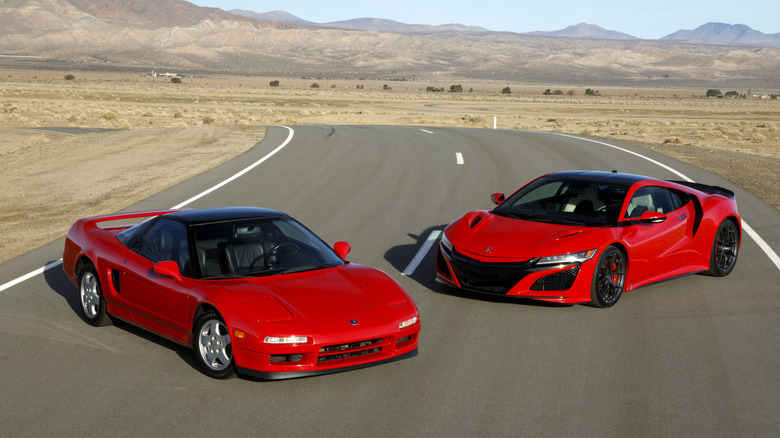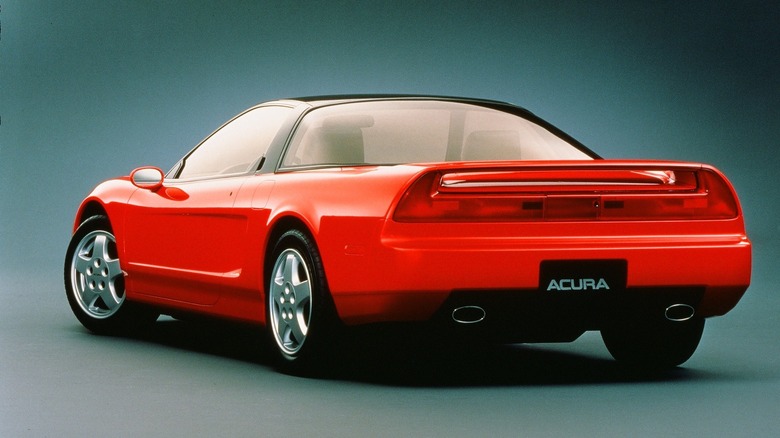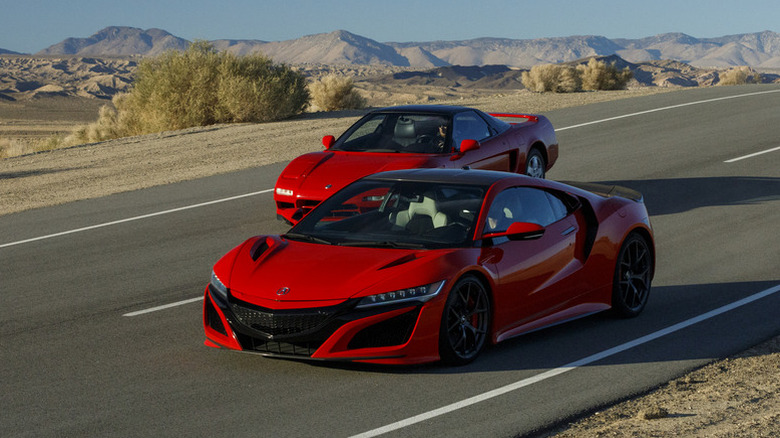What Does Acura's 'NSX' Model Name Stand For?
The Acura brand launched in March 1986. And just three years later, it revealed an early version of what would become one of the most iconic sports cars of all time, the NSX. The NSX had been in development at Honda for years, with prototypes and development strategies going back as far as 1984 — predating the Acura brand entirely. Even the famous F1 driver Ayrton Senna was part of the process, giving input that would eventually lead to a stiffer, better-performing production version of the NSX. In 1989, the Acura NS-X debuted at the Chicago Auto Show, two years before the car went on sale in its production form. Yep, back then, it had a hyphen in the name, and its initials stood for "New Sportscar Unknown World."
Originally, the "X" in "NS-X" represented a mathematical unknown. "NS-X" wasn't the intended production name for the car — it was sort of a placeholder, but it eventually got chosen and adapted to "NSX" (without the hyphen), and the shift was made to call it "New Sportscar eXperimental" in the States. Whether you put a dash in there or not, the NSX name still represents one of the most impressive sports cars to ever be produced by Honda or Acura.
Success of the first-generation NSX
Early versions of the NSX were full of firsts. They were the first production cars to use an aluminum monocoque, and they used the first production engine with titanium connecting rods. Back in 1990, when 1991 NSX models first went on sale, they were priced around $65,000, making them the most expensive Japanese car ever. Just about every publication hailed the NSX as the greatest sports car they'd ever driven, and Acura sold 1,940 units in the first year of production.
The original NSX was powered by a 3.0-liter DOHC V6 with 270 horsepower and 210 pound-feet of torque. These numbers don't seem very large by today's standards, but they were more than enough for the day. After all, the NSX had a low curb weight of just 3,010 lbs, and with its mid-engine configuration, the overall balance was excellent.
In 1997, the NSX got a few significant performance upgrades with the introduction of a 3.2-liter V6 engine and a six-speed manual to replace the old five-speed. Power went up to 290 horses and 224 pound-feet of torque. Eventually, in 2002, the NSX got a styling update, and it switched from the classic pop-up headlights to more modern ones. We still rank those early models as some of the coolest cars with pop-up headlights ever built, but styling is certainly subjective.
The modern NSX took a while
After it was discontinued in 2005, the NSX went on a long hiatus. There was a concept version of the second generation of the NSX on display at the Detroit Auto Show as early as 2012, but a production model took three years to make it to the same auto-show floor. Eventually, the second-generation NSX went on sale in 2016 as a 2017 model, and it was a very different kind of performance car.
Instead of the standard 3.2-liter V6, the second-generation NSX got a twin-turbocharged 3.5-liter V6 engine that produced nearly double the power of the first-gen model. Paired with a hybrid system, the V6 in the 2017 NSX made a total of 573 horsepower and 476 pound-feet of torque. And instead of sending power to just the rear wheels, it was all-wheel drive. The price for all this added power and performance was definitely higher than the original model — it clocked in at $157,800 before the addition of any options (and there were a lot of available options).
Like the first-generation NSX, the second-gen model got more power and capability over time, and as we discovered in the mountains, the second-generation NSX was a treat to drive (here's why almost everyone was wrong about it). An upgraded NSX Type S debuted in 2021 with limited production numbers and an increase in power to 600 horsepower and 492 pound-feet. Sales for the second-generation NSX weren't great though, and in 2022, it was discontinued for a second time.


